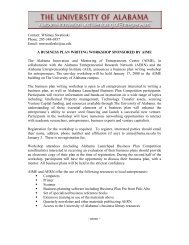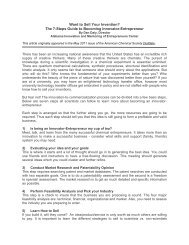2006 Annual Report - AIME - The University of Alabama
2006 Annual Report - AIME - The University of Alabama
2006 Annual Report - AIME - The University of Alabama
Create successful ePaper yourself
Turn your PDF publications into a flip-book with our unique Google optimized e-Paper software.
<strong>Alabama</strong> Institute for Manufacturing Excellence<br />
at<br />
<strong>The</strong> <strong>University</strong> <strong>of</strong> <strong>Alabama</strong><br />
ing a compelling case for corporations to<br />
invest in our inventions (license game)<br />
and/or encourage entrepreneurs to invest<br />
their efforts in our inventions (startup<br />
company game).<br />
• Innovation, the act <strong>of</strong> adding value to<br />
new knowledge or intellectual property,<br />
presumably for commercial purposes,<br />
requires a sustainable innovation ecosystem.<br />
• <strong>The</strong> innovation ecosystem in a university<br />
requires people (faculty, staff<br />
and students) who already are part <strong>of</strong><br />
the infrastructure as<br />
well as physical infrastructure.<br />
• <strong>The</strong> mission <strong>of</strong> universities<br />
is to educate<br />
and train students in<br />
all facets <strong>of</strong> the competitiveness<br />
agenda<br />
in an integrated manner.<br />
Through our Entrepreneurship<br />
training, CEOs and CTOs<br />
will emerge to be integrated into these<br />
locally established start-up companies.<br />
Universities traditionally are the principal<br />
generators <strong>of</strong> new knowledge and early<br />
stage IP. A conclusion to be drawn from<br />
the above facts is that they need to fill the<br />
innovation gap and position themselves<br />
higher on the commercial value chain by<br />
forming innovation research centers and<br />
engaging in R&D to add commercial value<br />
to IP. Such innovation centers should be in<br />
addition to an <strong>of</strong>fice <strong>of</strong> technology transfer<br />
and a business incubator and form part <strong>of</strong><br />
an integrated system known as the innovation<br />
ecosystem. However, to carry out the<br />
broader vision <strong>of</strong> <strong>The</strong> <strong>University</strong> <strong>of</strong> <strong>Alabama</strong><br />
as a student-centered research university,<br />
it is important that students and their education<br />
be an integral part <strong>of</strong> the innovation<br />
ecosystem. How can we accomplish these<br />
multi-faceted goals at UA<br />
NEW <strong>AIME</strong><br />
<strong>The</strong> proposal <strong>of</strong> OR is that we reconstitute<br />
<strong>AIME</strong> and significantly enhance what<br />
is already being done,<br />
but emphasize and develop<br />
an innovation ecosystem<br />
driven by the<br />
involvement <strong>of</strong> both undergraduate<br />
and graduate<br />
students. Our plan is<br />
modeled on the thinking<br />
behind the “moot corp”<br />
program at <strong>The</strong> <strong>University</strong><br />
<strong>of</strong> Texas at Austin, but takes a rather<br />
different form (see: http://www.mootcorp.<br />
org/). <strong>The</strong> plan also involves a modification<br />
<strong>of</strong> the strategy behind DARPA.<br />
<strong>The</strong> “moot corp” program at UT involves<br />
running a business competition for funding<br />
new startup ventures. At UA we want to start<br />
with intellectual property that has been disclosed<br />
to UA, build an entrepreneurial team<br />
composed <strong>of</strong> faculty and students around a<br />
given IP, develop an innovation<br />
and marketing plan for<br />
the IP, compete the IP before<br />
a moot “venture capital (VC)”<br />
11





